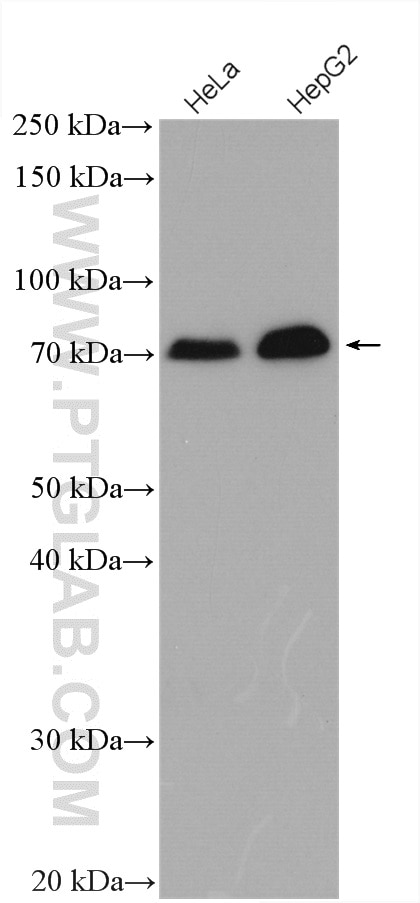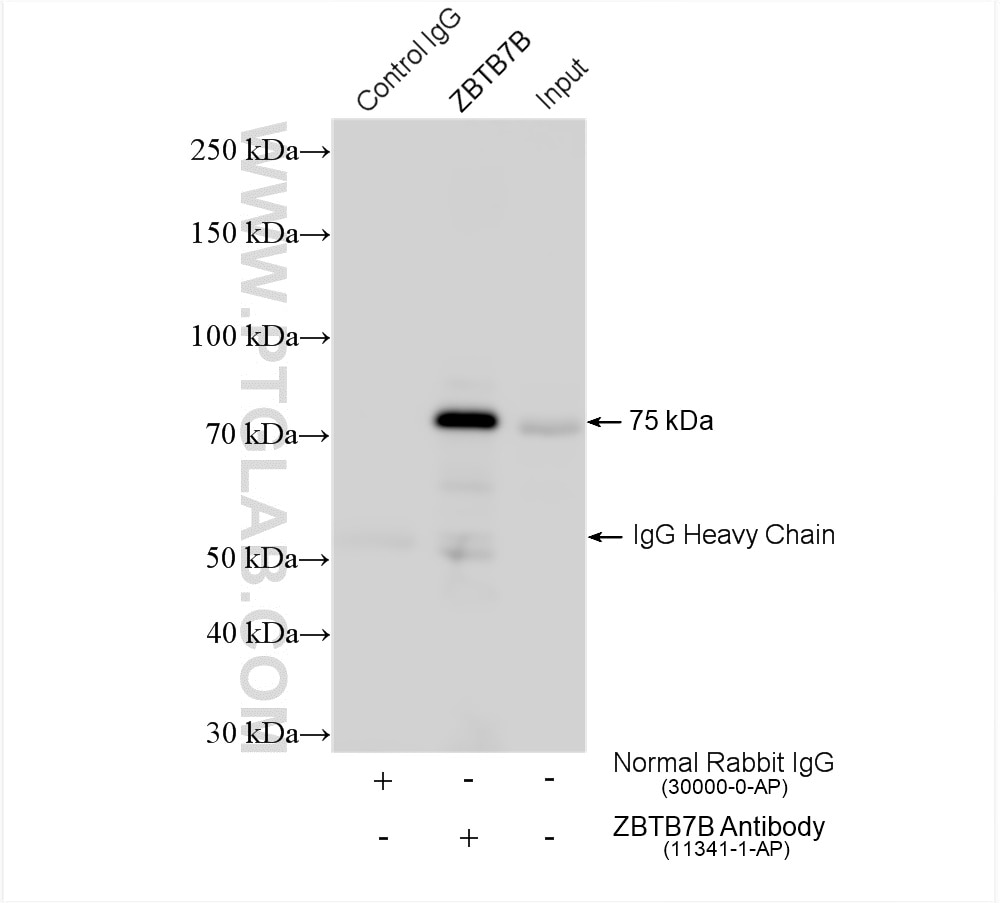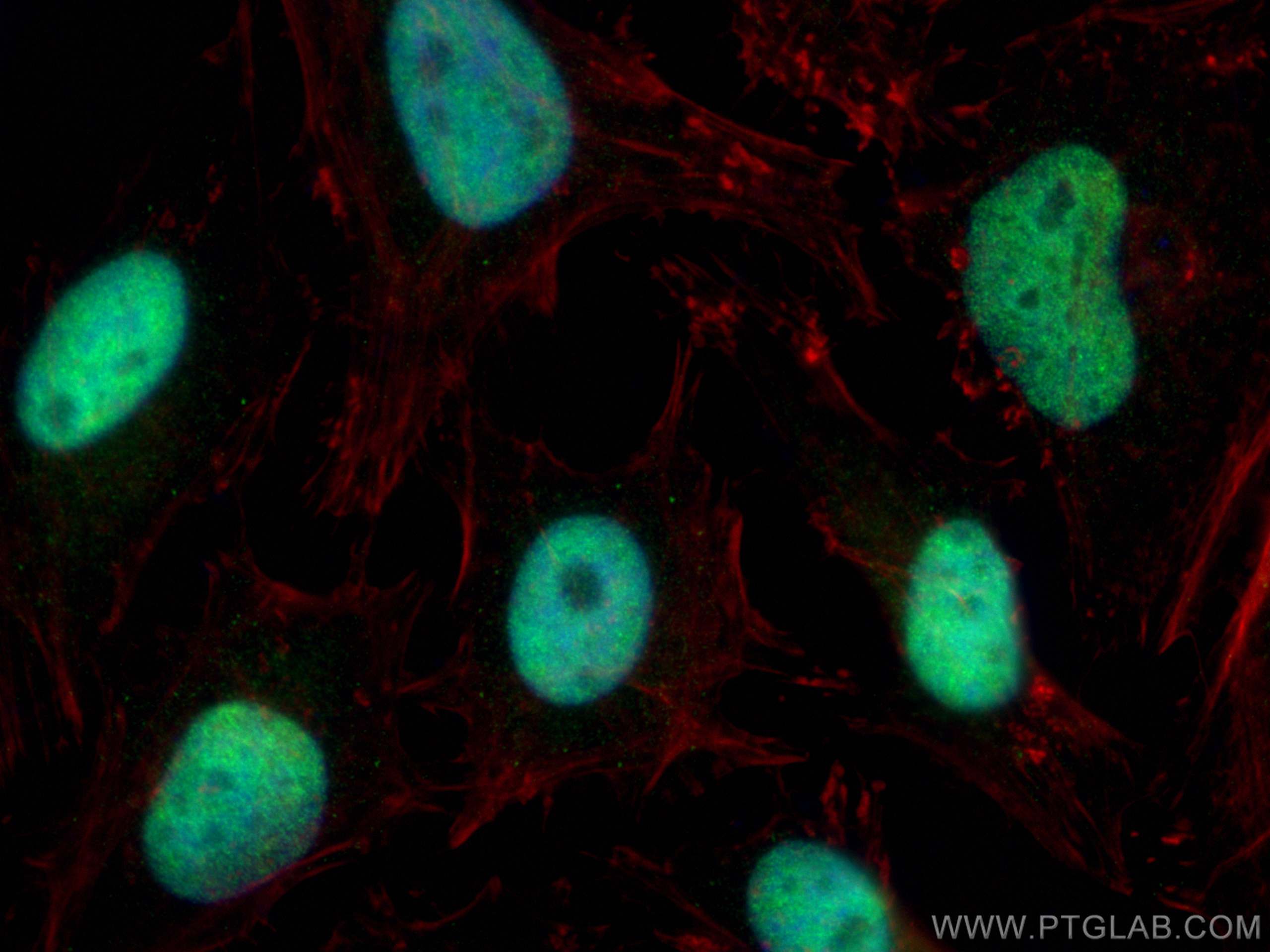Validation Data Gallery
Tested Applications
| Positive WB detected in | HeLa cells, HepG2 cells |
| Positive IP detected in | HeLa cells |
| Positive IF/ICC detected in | HeLa cells |
Recommended dilution
| Application | Dilution |
|---|---|
| Western Blot (WB) | WB : 1:1000-1:4000 |
| Immunoprecipitation (IP) | IP : 0.5-4.0 ug for 1.0-3.0 mg of total protein lysate |
| Immunofluorescence (IF)/ICC | IF/ICC : 1:800-1:3200 |
| It is recommended that this reagent should be titrated in each testing system to obtain optimal results. | |
| Sample-dependent, Check data in validation data gallery. | |
Published Applications
| WB | See 4 publications below |
| IHC | See 2 publications below |
| IP | See 1 publications below |
Product Information
11341-1-AP targets ZBTB7B in WB, IHC, IF/ICC, IP, ELISA applications and shows reactivity with human, mouse, rat samples.
| Tested Reactivity | human, mouse, rat |
| Cited Reactivity | human, mouse, bovine, hamster |
| Host / Isotype | Rabbit / IgG |
| Class | Polyclonal |
| Type | Antibody |
| Immunogen | ZBTB7B fusion protein Ag1888 相同性解析による交差性が予測される生物種 |
| Full Name | zinc finger and BTB domain containing 7B |
| Calculated molecular weight | 539 aa, 58 kDa |
| Observed molecular weight | 60-65 kDa |
| GenBank accession number | BC012070 |
| Gene Symbol | ZBTB7B |
| Gene ID (NCBI) | 51043 |
| RRID | AB_2217245 |
| Conjugate | Unconjugated |
| Form | Liquid |
| Purification Method | Antigen affinity purification |
| Storage Buffer | PBS with 0.02% sodium azide and 50% glycerol , pH 7.3 |
| Storage Conditions | Store at -20°C. Stable for one year after shipment. Aliquoting is unnecessary for -20oC storage. |
Background Information
ZBTB7B belongs to a large family of transcription factors, generally acting as repressors, characterized by a carboxy-terminal DNA binding domain made of multiple zinc fingers (four in Thpok) and an amino-terminal BTB-POZ domain that mediates homo- (and possibly hetero-) dimerization [PMID: 17084908]. Zbtb7b is up-regulated by MHC-II-restricted thymocytes during their CD4 differentiation and is a major determinant of CD4 lineage choice. Two properties of ZBTB7B deserve attention. First, although Thpok is expressed in a wide variety of cells, its expression in the thymus is highly lineage-specific : CD4 SP thymocytes (and all CD4 T cells) express Thpok, whereas DP and CD8 SP thymocytes do notSecond, both loss- and gain-of-function experiments indicate that Thpok affects lineage choice but not positive selection [PMID: 15729333, 10550051].
Protocols
| Product Specific Protocols | |
|---|---|
| WB protocol for ZBTB7B antibody 11341-1-AP | Download protocol |
| IF protocol for ZBTB7B antibody 11341-1-AP | Download protocol |
| IP protocol for ZBTB7B antibody 11341-1-AP | Download protocol |
| Standard Protocols | |
|---|---|
| Click here to view our Standard Protocols |
Publications
| Species | Application | Title |
|---|---|---|
Acta Biomater LAP2β transmits force to upregulate genes via chromatin domain stretching but not compression | ||
J Nanobiotechnology Edible exosome-like nanoparticles from portulaca oleracea L mitigate DSS-induced colitis via facilitating double-positive CD4+CD8+T cells expansion | ||
J Agric Food Chem Acylated Ghrelin Activates PI3K/mTOR Signaling Pathway by Promoting ThPOK Acetylation to Promote Milk Fat Synthesis in Bovine Mammary Epithelial Cells | ||
J Transl Med Epigenetic DNA methylation of Zbtb7b regulates the population of double-positive CD4+CD8+ T cells in ulcerative colitis. |


